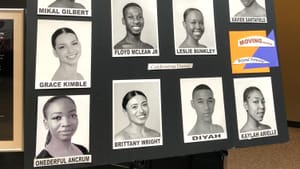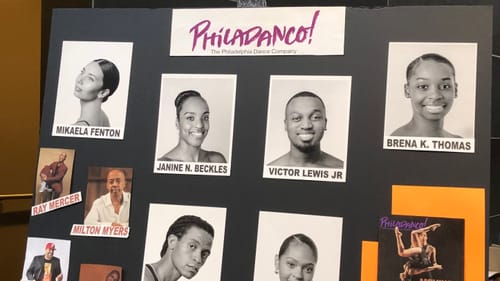Stay in the Loop
BSR publishes on a weekly schedule, with an email newsletter every Wednesday and Thursday morning. There’s no paywall, and subscribing is always free.
Technique and soul
PHILADANCO! presents Moving... Beyond Forward

During a talk-back after the Friday, April 21, opening-night performance of PHILADANCO!’s Moving… Beyond Forward at the Kimmel’s Perelman Theater, choreographer Milton Myers pointed out that technique is important, but a dancer has to bring their soul to the performance.
When you look past the bravura strength and the flash of bodies in flight, PHILADANCO!’s spring 2023 program presented the soul of a community formed around the company since its inception. Ray Mercer and Myers have been creating for PHILADANCO! for decades, and Rennie Harris and Tommie-Waheed Evans were dancers there. It’s almost like watching a secret language of care and solidarity nurturing the souls of the dancers.
Dance for the sake of dance
World-premiere Balance of Power was billed as a celebration of “dance for the sake of dance,” and Mercer’s choreography flirts with a variety of styles. It opened with contemporary on a dark stage with a single spotlight highlighting Mikaela Fenton, held aloft by the men of the company. Mercer added a touch of hip-hop, then brought the men together like a fraternity step team—or a Broadway ensemble.
The movement was sharply articulated throughout. In a trio of women, the soft positions of their hands set off their angular upraised arms. But from the title to the intense percussive score by South African composer Bongi Duma, to the men’s dark suits with a flash of purple in the lining, the piece seemed to talk about the struggle for community, at home and in the world. The men stepping in their power suits might have been going off to a corporate war. When the women joined them in their black pants and bandeau tops, they donned the jackets in a twist of moves that almost seemed like magic. The war was now between the sexes and the women leapt at the men in a sequence of the company’s trademark flying lifts.
The Element and Fear
Myers called The Element in Which It Takes Place a rite of passage, or rite of spring, and said in the program notes that the dance explores the women’s sensitivity and strength, and their sensuality and aggression. He created it for the company in 1987, but invited the dancers to contribute to the refreshed version, which felt immediate in its raw sensuality.
As the piece opened, the word Koyaanisqatsi (“life out of balance”) rang out, introducing the score by Philip Glass and Meredith Monk. The women dominated the stage in short shirts with a grass-like front panel, mythic Amazons stepping down from a Greek frieze: in one repeated move, they seemed to draw a bow and arrow. When the men arrived, in red shorts, the two groups faced off across the stage, with only their breathing for a soundtrack. With deep open plies and suggestive hip rolls, the mood shifted to sweaty sex. In a sequence of lifts by William Burden, Fenton flung her legs in the air as the mood grew almost frenzied with explosive energy.

Harris’s Fear opened with a heartbeat on a mostly darkened stage. Dancer Leslie Bunkley seemed to be tap-dancing but without the taps, and the women of the company joined her in their jeans and dark shirts. The dancers raised their arms in the Egyptian pose that read more like the “hands in the air” of a police stop here, and a simple step exquisitely represented the anxious dread of the title. The dancers’ free leg curled over the support leg, sliding up slowly, then curving around to slide down the back of the leg, a familiar twisted pose that almost made me draw my own arms protectively around me. But Harris blended the tense moments with sequences evoking the social dance of the 1970s, reminding us that from its origin, hip-hop has celebrated joy.
Memory and story
In 2021, the company lost beloved rehearsal director and teacher Deborah Chase Hicks. In his world-premiere Somewhere Between Heaven and Earth, Evans celebrates her memory. The pulsing House music—and Evans’s vocabulary of spins, extensions, and leaps—demanded big movement, and the company delivered. The men soared across the stage, the fringe down the sides of their tapered pants flying out in vees of flashing fabric that filled the space around them. The women, in jewel colors, stayed closer to the ground, but still showed some lovely held extensions. An intense duet between Mikal Gilbert and Brandi Pinnix featured a sequence of lifts that ended with Gilbert draped across Pinnix’s bent knees. One got the sense that Gilbert’s grief had spun itself out and rested in the memory of the absent teacher.
I want to put in a last word for the costume designers Natasha Guruleva, for Balance of Power and The Element in Which It Takes Place, and Anna-Alisa Belous for Between Heaven and Earth. In a dance world full of slip dresses and tee shirts, it was delightful to see costumes not just setting the tone, but telling the story.
What, When, Where
Moving... Beyond Forward. Choreography by Milton Myers, Ray Mercer, Rennie Harris, and Tommie-Waheed Evans. PHILADANCO! presented by the Kimmel Cultural Campus. $29-$49 ($11.50 fee for online orders). April 21 through 23, 2023, at the Kimmel Cultural Campus's Perelman Theater, 260 S Broad Street, Philadelphia. (215) 387-8200 or philadanco.org.
Accessibility
The Kimmel Cultural Campus is an ADA-compliant venue. Patrons can purchase wheelchair seating or loose chairs online by calling patron services at (215) 893-1999 or by emailing [email protected]. With advance notice, patron services can provide options for personal care attendants, American Sign Language, Braille tickets and programs, audio descriptions, and other services.
Masks are not required in Kimmel Cultural Campus venues.
Sign up for our newsletter
All of the week's new articles, all in one place. Sign up for the free weekly BSR newsletters, and don't miss a conversation.

 Camille Bacon-Smith
Camille Bacon-Smith